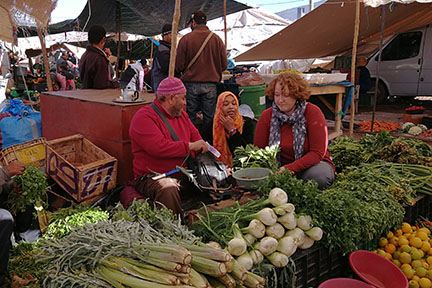IMAGE OF THE WEEK
 Bronwen Powell (right) shared this photo from Asni Market in the High Atlas Mountains near Marrakech, Morocco in December 2017. She is interviewing a vendor and assisted by a translator.
Bronwen Powell (right) shared this photo from Asni Market in the High Atlas Mountains near Marrakech, Morocco in December 2017. She is interviewing a vendor and assisted by a translator.
GOOD NEWS
- April 18 at 7:00 p.m., the GIS Coalition will be holding its final meeting of the semester in 229 Walker Building. Guest speaker Mark Simpson will talk about GIS and virtual reality for data representation.
- April 28, from 9:30 a.m. to 12:30 p.m., SWIG will be hosting three interactive workshops teaching girls the importance of space and place by using maps/cartography, aerial photography, and VR, as part of Graduate Women in Science (GWIS) biannual Girl Scout Workshop.
- Guido Cervone received a College of Earth and Mineral Sciences postdoctoral award, which will fund a postdoctoral position for two years.
- Eden Kinkaid passed her dissertation proposal defense on April 16.
- At the 2018 AAG annual meeting, alumnus Jase Bernhardt (’16g), now in the Department of Geology, Environment and Sustainability at Hofstra University, was elected director of the AAG Climate Specialty Group.
- Hari Osofsky’s Emory Law Journal article, Energy Partisanship, (with University of Melbourne’s Jacqueline Peel) was awarded the 2018 Morrison Prize, which recognizes the most impactful sustainability-related legal academic article published in North America during the previous year.
- Next year’s SWIG officers will be Ruchi Patel, Michelle Ritchie, Elli Nasr, and Emily Domanico.
COFFEE HOUR
The Miller Lecture with Ariel Anbar: Education Through Exploration: Reimagining Learning in a Digital Age
Digital learning environments are being developed to meet the need for discovery-based and active learning at scale, enabling pedagogy that is interactive and adaptive to the learner as well as new modes of assessment. Building on the successes of tools and platforms such as the Khan Academy, Coursera, EdX, and PhET, the sophistication of interactivity, adapativity, and assessments continues to improve, driven by a combination of technological innovation and learning sciences research. This convergence creates new possibilities, but demands new approaches to the design of learning experiences.
- 3:00 to 5:00 p.m.: Refreshments are offered in 319 Walker Building at 3:00 p.m.; the lecture begins in 112 Walker Building at 4:00 p.m.
- Coffee Hour To Go Webcast
NEWS
Preserving Seeds of Knowledge: Natural history flourishes at Penn State’s PAC Herbarium
Located in the Whitmore Lab on the Penn State campus, the PAC Herbarium may be one of University Park’s best-kept secrets.
Cabinets and shelves are lined with more than 107,000 carefully dried, preserved, and mounted plant specimens from around the world. The room’s temperature is kept at 69 degrees throughout the year to keep mold and insects away. Treasured specimens collected by Evan Pugh, Penn State’s first president, showcase the legacy of the herbarium and the role it has played in the university’s history as a leader in agricultural sciences.
Public Mapping Project wins 2018 Brown Democracy Medal
As conversations about how to stop partisan gerrymandering continue around the country, the work being done by this year’s Brown Democracy Medal winner could not be more timely or more relevant.
The McCourtney Institute for Democracy will award the 2018 Brown Democracy Medal to the Public Mapping Project, an initiative led by Micah Altman, director of research and head of the program on information science at Massachusetts Institute of Technology, and Michael McDonald, associate professor of political science at the University of Florida.
One-fifth of carbon entering coastal waters of eastern North America is buried
Coastal waters play an important role in the carbon cycle by transferring carbon to the open ocean or burying it in wetland soils and ocean sediments, a new study shows.
The team, led by Raymond Najjar, professor of oceanography in Penn State’s College of Earth and Mineral Sciences, constructed the first known carbon budget of the eastern coast of North America from the southern tip of Nova Scotia, Canada, to the southern tip of Florida. They tracked the flows of organic and inorganic carbon into and out of coastal waters.
RECENTLY PUBLISHED
Advancing Dendrochronological Studies of Fire in the United States
Harley GL, Baisan CH, Brown PM, Falk DA, Flatley WT, Grissino-Mayer HD, Hessl A, Heyerdahl EK, Kaye MW, Lafon CW, Margolis EQ, Maxwell RS, Naito AT, Platt WJ, Rother MT, Saladyga T, Sherriff RL, Stachowiak LA, Stambaugh MC, Sutherland EK, Taylor AH.
Fire. 2018; 1(1):11
doi:10.3390/fire1010011
Dendroecology is the science that dates tree rings to their exact calendar year of formation to study processes that influence forest ecology (e.g., Speer 2010 [1], Amoroso et al., 2017 [2]). Reconstruction of past fire regimes is a core application of dendroecology, linking fire history to population dynamics and climate effects on tree growth and survivorship. Since the early 20th century when dendrochronologists recognized that tree rings retained fire scars (e.g., Figure 1), and hence a record of past fires, they have conducted studies worldwide to reconstruct [2] the historical range and variability of fire regimes (e.g., frequency, severity, seasonality, spatial extent), [3] the influence of fire regimes on forest structure and ecosystem dynamics, and [4] the top-down (e.g., climate) and bottom-up (e.g., fuels, topography) drivers of fire that operate at a range of temporal and spatial scales. As in other scientific fields, continued application of dendrochronological techniques to study fires has shaped new trajectories for the science. Here we highlight some important current directions in the United States (US) and call on our international colleagues to continue the conversation with perspectives from other countries.
